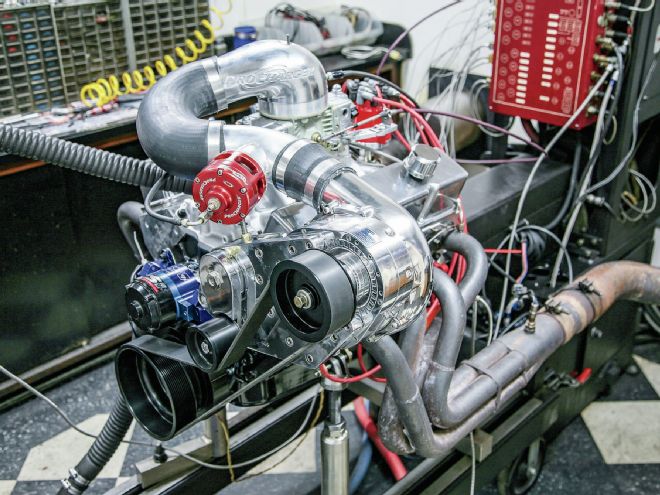
As the adage goes, risk is not without reward. Truthfully, gearheads know this better than anyone thanks to painfully expensive lows that make us question both our sanity and our commitment to the sport.
But for every failed attempt there’s also a success story with a high so ceremoniously victorious that all travesties on the path to greatness are forgotten. Maybe it was an ever-elusive dyno number, a hard-to-get e.t., or a flying lap; but no matter the goal, few things in life are as satisfying.
We’d be lying if we said this temptation to push the envelope wasn’t the impetus for this story. In truth, it all started innocently enough with lunchtime shoptalk that quickly ignited into all-out bench racing. In an instant, an idea was born, the challenge was made, and we immediately questioned our own judgment.
The Plan
The mission was simple, but that didn’t mean it was going to be easy: See what a quality naturally aspirated GM-based 383 crate engine makes on the dyno under its own merit and then tickle it with some boost from a big, bad ProCharger F-1A-94 supercharger, a blower that’s lighting the drag racing world on fire.
We knew that the pairing of boost with the capable BluePrint Engines’ stroker crate engine would instantly put the stock block in jeopardy, but as they say, temptation is a powerful motivator. How much would it make on 6 psi? How about 8 or even 12 psi? We weren’t sure, but we were determined to find out.
We’re in Good Hands
Before putting the cart before the horse, we consulted with the godfathers of old-school Southern California horsepower at Vrbancic Brothers Racing. Bob and George have been building big power pushrod engines for decades, and to say they know a thing or two would be an understatement. They’ve run countless high-horsepower engines on their state-of-the-art DTS engine dyno and have forgotten more than we’ll ever hope to know.
They’re also experts in the field of blow-through carburetors since they own the highly regarded Carb Shop as well—another legend in the industry that’s conveniently located next door.
Our hesitation in sharing our crazy idea with the Vrbancic brothers was immediately alleviated the minute Bob said “We can safely sneak up on 700 hp with the right fuel, the right timing, and some tweaks.” And that is how this story went from rhetoric to reality.
Crate Expectations
It’s long been understood that BluePrint Engines makes some of the nicest short-blocks and crate engines in the industry, that are admirably assembled and shipped in the good ol’ USA.
BluePrint has been around for more than two decades and was founded by Norris Marshall, a diehard gearhead who wanted to provide OEM-quality engines at affordable prices; and 20 years later he’s still at it with quality engines and even proprietary block and cylinder head castings. If that doesn’t say something of BluePrint’s caliber, we don’t know what does.
According to BluePrint, customer feedback drives the design, development, and engineering of their products. In fact, each engine is not only dyno tested before it leaves the building, but it’s backed by a 30-month/50,000 mile warranty—talk about having your cake and eating it too.
Our particular example is the BP38316CT1; a boost-friendly, aluminum-headed, roller cam 383. BluePrint explained that it was designed with forced-induction as the end result. But knowing that many enthusiasts add modifications in stages, they massaged the combo to make a stout 440 hp and 445 lb-ft without the aid of boost.
As for the particulars, it utilizes a four-bolt main block that’s been sonic tested and had the bearing bores align-honed and the cylinders computer-honed to 0.0002-inch for roundness and straightness.
Inside the block you’ll find plenty of quality parts; like a forged 3.75-inch stroker crank, forged rods, and matching forged pistons with Hastings moly rings, a Melling high-volume oil pump, and a heavy-duty double roller timing set.
A hydraulic roller cam that measures 0.536/0.555 lift, 113-degree lobe separation angle, with a duration at 0.050 of 224/236 tickles the swirl-polished 2.02 intake and 1.60 exhaust valves that work with hardened retainers and springs. The castings are a BluePrint aluminum performance variant that utilize 195cc intake and 75cc exhaust runners with 64cc chambers. The entire combo arrives at a boost-friendly compression ratio of 8.5:1.
Big Boost, Small Package
If ever there was a case of not judging a book by its cover, the newly updated ProCharger F-1A-94 would undoubtedly be it. Like its F-series brethren, it features a 7075 billet aluminum impeller, CNC-machined transmission case, as well as ProCharger’s patented compound bearing design and self-contained oiling system.
It too shares the same compact 9-inch volute as the standard F-1A and the smaller D-1SC and P-1SC head units, but when the boost is turned up, the 94 turns into a beast.
“We spent a lot of R&D on the new impeller design and the volute to maximized airflow at higher boost and faster impeller speeds,” said Sergio Shifman of ProCharger.
He further explained that the magic is in the angle and design of the blades. Specifically, the relationship between the exducer (the base of the blades that are closest to the center shaft) and the inducer (the outermost portions of the blades) has been precisely designed to shine at high boost.
Although ProCharger claims the standard F-1A is a better street blower because it trades top-end power for more midrange boost, as you’ll see from the dyno, even at low boost the 94 kicks butt.
What about that judging a book by its cover? Well, we must add that the F-1A-94 is capable of over 1,100 hp and has already pushed an IRS-equipped, 3,600-pound fifth-gen Camaro to 176 mph in the quarter-mile. But here’s the catch; as mentioned, this blower shares the same volute and case as the smaller, more common D-1SC and P-1SC blowers. Because they look identical, this means that if you were the type that plays your cards close to your vest, nobody would call your bluff until you blew their doors off.
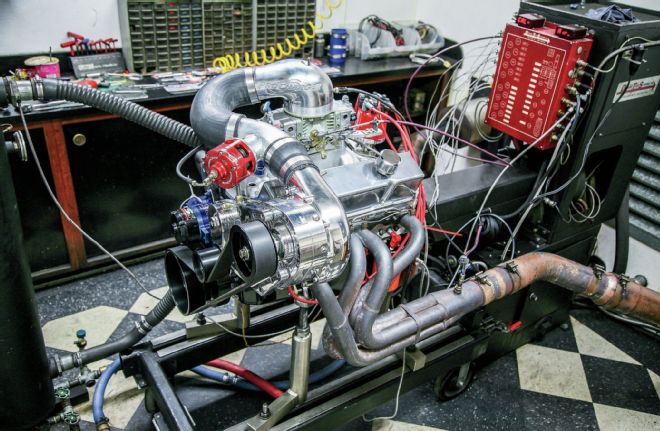
01. Behold, the new ProCharger F-1A-94 bolted to a BluePrint 383 crate engine: The easy recipe for big power. How much? Read on for the report from our visit to Vrbancic Brothers Racing for two days of dyno thrashing.
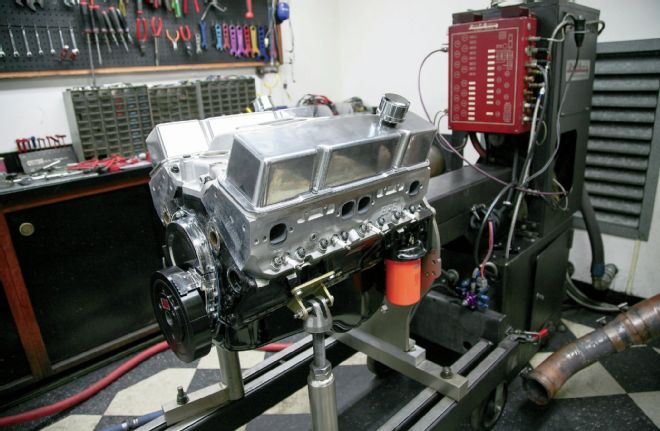
02. The BluePrint Engines aluminum-headed, hydraulic roller, fully forged, boost-ready 383 small-block was our engine of choice. It features a 30-month/50,000-mile warranty, costs approximately $5,300 and is said to make 440 hp and 445 lb-ft.
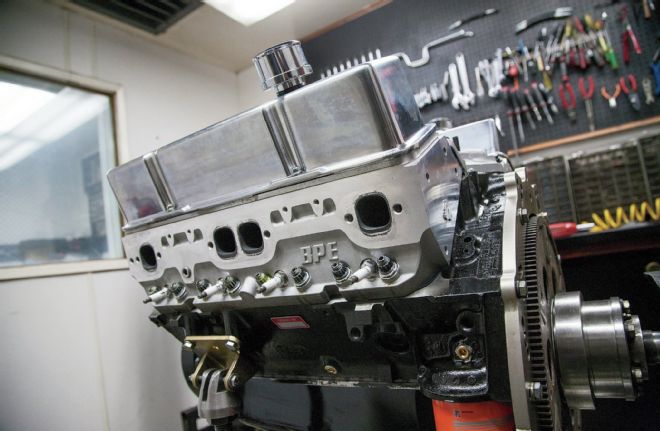
03. BPE aluminum cylinder heads feature swirl-polished 2.02 intake and 1.60 exhaust valves, 195cc intake and 75cc exhaust runners, and 64cc chambers that bring the compression to a boost-friendly 8.5:1. A hydraulic roller cam that measures 0.536/0.555-inch lift, 113-degree lobe separation angle, and 224/236-degree duration at 0.050 also joins the party.
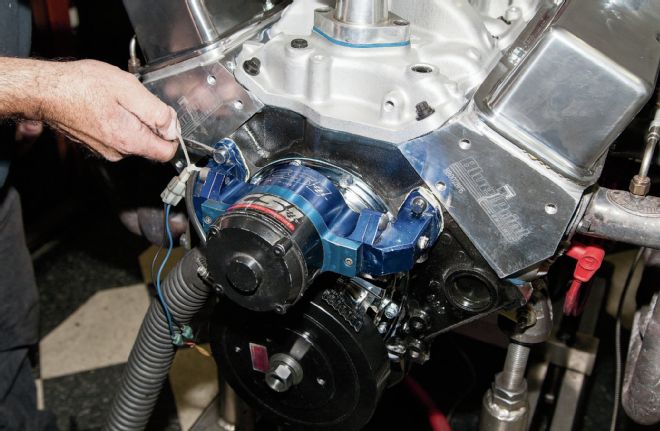
04. Vrbancic Brothers Racing uses a CSI billet electric water pump to keep water temps cool and consistent.
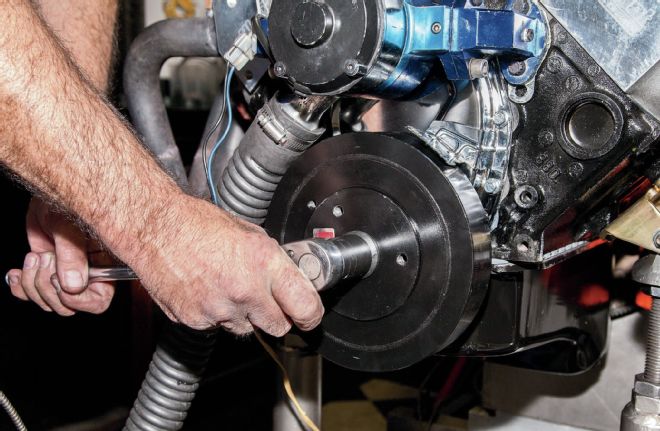
05. Our BluePrint Engines 383 did not come with a balancer; thankfully the crew at Vrbancic had a Professional Products unit on hand. Note, the engine required a non-weighted 8-inch balancer and a late 350 weighted flexplate/flywheel.
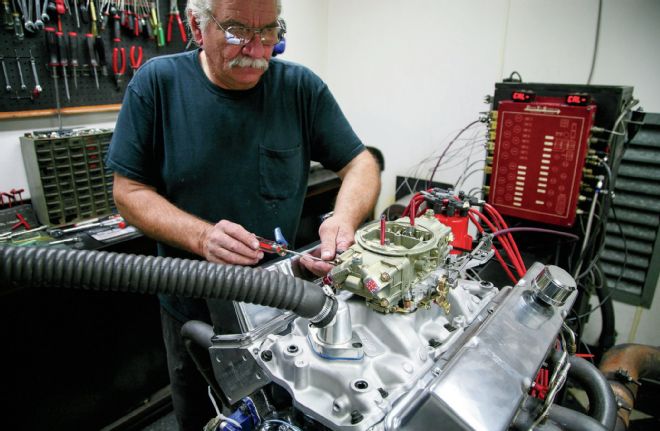
06. Let’s not forget the Carb Shop-modified Holley 750-cfm double-pumper and Pro Comp Motorsports dual-plane intake manifold that were used for the test.
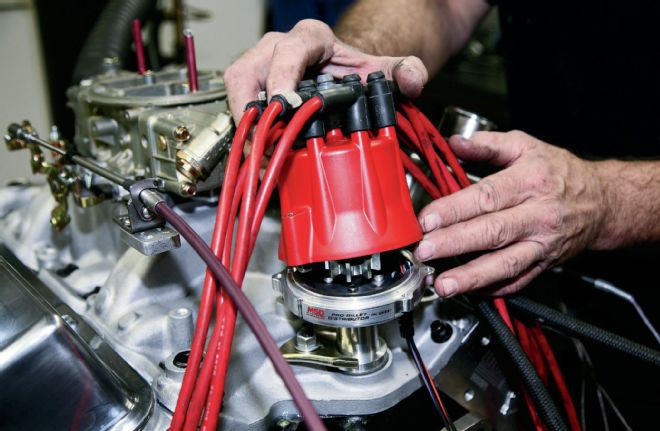
07. A quality stroker needs a proper distributor, so we used an MSD Pro-Billet to bring the heat.
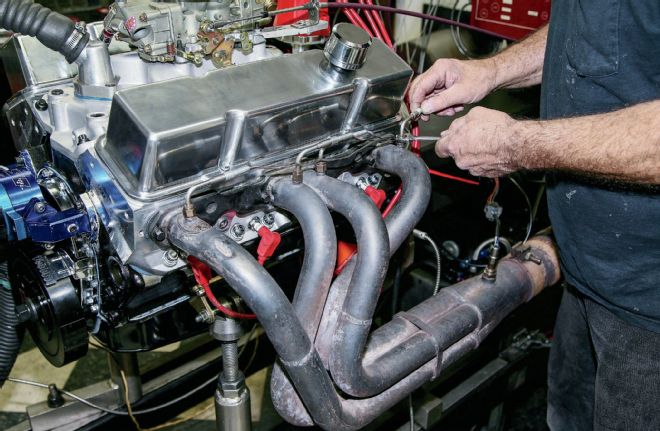
08. The DTS Engine dyno measures a plethora of information that allows the Vrbancic brothers to extract maximum horsepower. The long-tube dyno headers featured 1 7/8-to-2-inch stepped primaries that feed 3.5-inch collectors. Here, George Vrbancic is seen securing the individual exhaust gas temperature probes followed by the wideband O2 sensors.
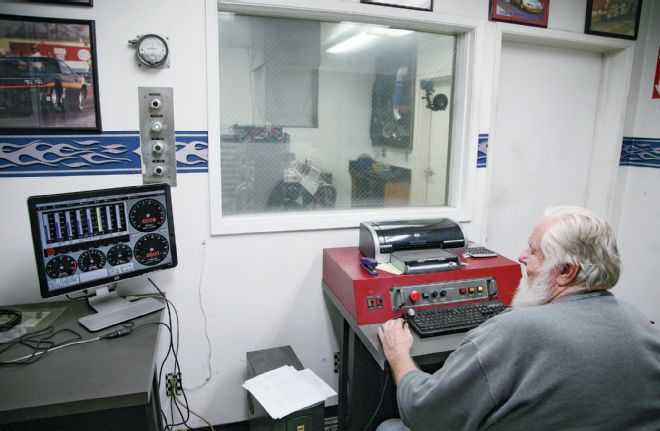
09. George Vrbancic is the man at the helm of the dyno. The crew started with conservative timing, air/fuel ratios, and a low rev ceiling before deciding the engine liked 33 degrees of total timing and a rev limit of 5,500 rpm. Any higher and the supplied valvesprings produced valve float.
Dyno Time Naturally Aspirated
After adding a Pro Comp Motorsports dual-plane intake manifold, a Professional Products damper, Autolite spark plugs, a Carb Shop-modified 750-cfm Holley double-pumper carburetor, a CSI electric water pump, the stepped 1 7/8-to-2-inch dyno headers with 3.5-inch collectors, and some 91-octane pump gas, the Vrbancic brothers quickly found the optimal timing, air/fuel ratio (AFR), and rev ceiling. It liked 33 degrees of total timing, an AFR in the 12s, and 5,500 rpm; anything higher and the stock springs would cause valve float.
But more rpm didn’t matter, as the low-compression stroker still pounded out 427.7 hp at 5,500 rpm and 459.6 lb-ft at 4,300 rpm. That’s solid power considering its compression. But power is only part of the equation, as the stroker produced a pancake flat torque curve with over 430 lb-ft from 3,000 rpm upward. As anyone will tell you, torque is what moves street cars.
It’s Blower Time
Under the watchful eye of Vrbancic Brothers Racing, the crew added another Carb Shop-modified Holley 750-cfm carb atop a 1-inch spacer, but this carb was designed for a blow-through setup. Next came the wicked ProCharger F-1A-94 supercharger and its entourage of billet bits. Although it was overkill, for safety’s sake we bought some Torco 118-octane racing fuel from Sunol Super Stop to erase all doubt of possible detonation because the dyno tests were performed without an intercooler. It’s interesting to note that the blower was so efficient that IATs were barely over ambient even without an intercooler. Speaking of which, ProCharger supercharger kits are available with optional air-to-air intercoolers that make these horsepower figures possible on pump gas.
Again, the Vrbancic brothers quickly found the optimum settings for our boosted stroker. The timing was set at 26 degrees, the AFRs were slightly richer for safety’s sake, and the rev ceiling was still 5,500 rpm.
With the big ProCharger barely breathing at just 8 psi of boost, power immediately jumped to a staggering 645 hp at 5,500 rpm and 624 lb-ft at 4,900 rpm. A swap to a slightly smaller pulley increased boost to 10 psi and pushed power to 677 hp and 655 lb-ft at the same rpm peaks.
We were so close to 700 hp we could taste it. So we left the timing at 26 degrees, but this time we locked the curve and pullied down ever so slightly. The results were nothing short of amazing: 701 hp and 685 lb-ft. Boost was now at 11.5 psi.
We were impressed that Bob had predicted the figure to a tee. How’s that for wisdom? But he was more impressed with the combo.
“The engine did really well and the blower is incredible since we were just starting to get into its efficiency range where boost comes in hard.”
ProCharger might have warned that the F-1A-94 is best when spun hard, but at only 11.5 psi our 383 stroker combo not only made big power, but it also was over 500 lb-ft at 3,000 rpm and over 600 lb-ft at 3,800 rpm. There’s nothing lazy about this blower; it’s the real deal, and we look forward to maxing it out on a dedicated race engine in the near future.
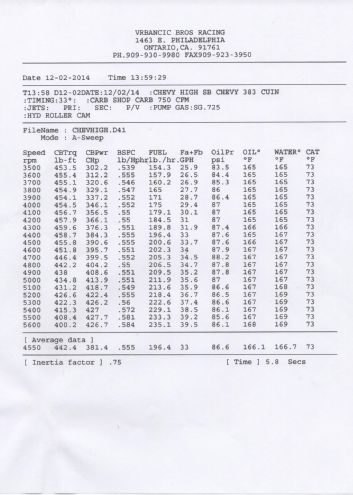 Despite a low 8.5:1 compression ratio that was designed with boost in mind, in naturally aspirated form the 383 made great power and huge torque. Peak figures were 427.7 hp at 5,500 rpm and 459.6 lb-ft at 4,300 rpm.
Despite a low 8.5:1 compression ratio that was designed with boost in mind, in naturally aspirated form the 383 made great power and huge torque. Peak figures were 427.7 hp at 5,500 rpm and 459.6 lb-ft at 4,300 rpm.
Despite a low 8.5:1 compression ratio that was designed with boost in mind, in naturally aspirated form the 383 made great power and huge torque. Peak figures were 427.7 hp at 5,500 rpm and 459.6 lb-ft at 4,300 rpm.
Despite a low 8.5:1 compression ratio that was designed with boost in mind, in naturally aspirated form the 383 made great power and huge torque. Peak figures were 427.7 hp at 5,500 rpm and 459.6 lb-ft at 4,300 rpm.
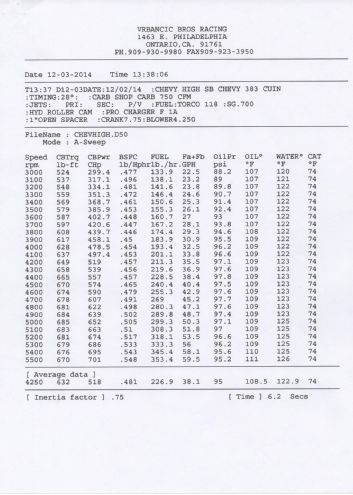 The addition of the Pro Charger on just 8 psi pushed power to 645 hp at 5,500 rpm and 624 lb-ft at 4,900 rpm, while 10 psi raised those figures to 677 hp and 655 lb-ft at the same peaks. Hungry for more, we pullied down for 11.5 psi and saw an astonishing 701 hp and 685 lb-ft.
The addition of the Pro Charger on just 8 psi pushed power to 645 hp at 5,500 rpm and 624 lb-ft at 4,900 rpm, while 10 psi raised those figures to 677 hp and 655 lb-ft at the same peaks. Hungry for more, we pullied down for 11.5 psi and saw an astonishing 701 hp and 685 lb-ft.
Final Thoughts
Truthfully, the big numbers are pushing the stock-block 383 beyond where we’d leave it for any length of time. If we were to run this combo in a street car, we’d back the boost down to the original 8 psi and enjoy a reliable 645 hp and 624 lb-ft on pump gas. It would produce massive torque and an even stronger top-end surge thanks to minimal boost and the highly capable crate engine. We also recognize that we haven’t even scratched the surface of the ProCharger F-1A-94’s capabilities. But as we’ve shown, even at these moderate boost levels, it’s a beast!
Stay tuned in the coming issues where we separate the two, as the 383 will soon find a home under the hood of a project car and the blower will land on an engine capable of maxing it out. But for now, we’ll bask in the victory of an easy 700 hp.
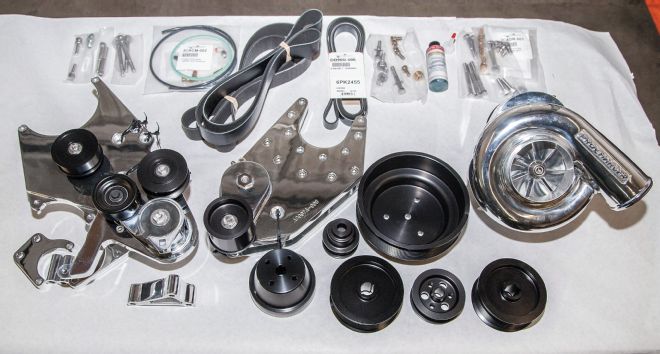
10. Thankfully, the non-intercooled, blow-through carbed ProCharger setup is as complete as it is affordable with an approximate retail of $4,750 for the standard kit; however, ours retailed slightly higher thanks to the polished finish throughout, the serpentine accessory drive, and the competition carb bonnet (not shown). Big boost aside, the high-quality luster of the polish is show-car cool.
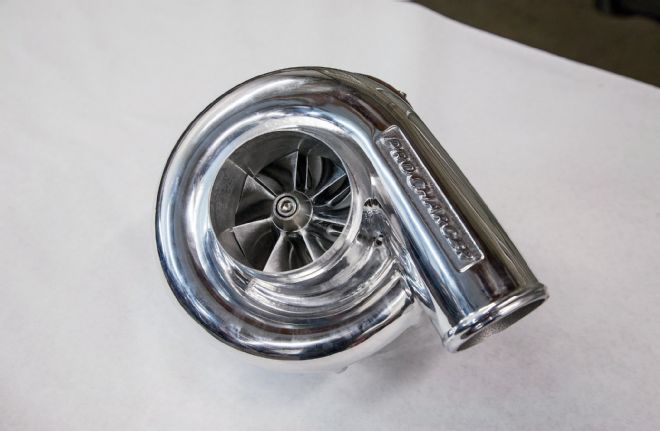
11. The newly released ProCharger F-1A-94 could be the biggest sleeper modification of 2015. It might share the same 9-inch volute as the more common, and smaller P-1SC and D-1SC head units, but this bad boy is good for over 1,100 hp!
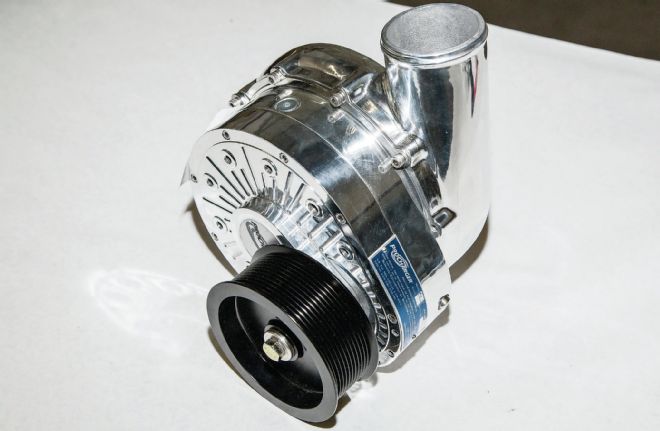
12. Like its F-series brethren, it features a 7075 billet aluminum impeller, a CNC-machined transmission case, and hardy internal gears with an aggressive step-up ratio.
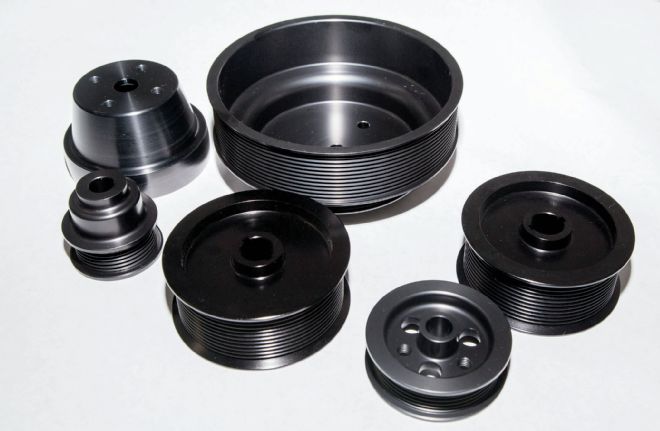
13. We opted to use the 12-rib setup, but should you want a race-ready cog drive, that’s also an option.
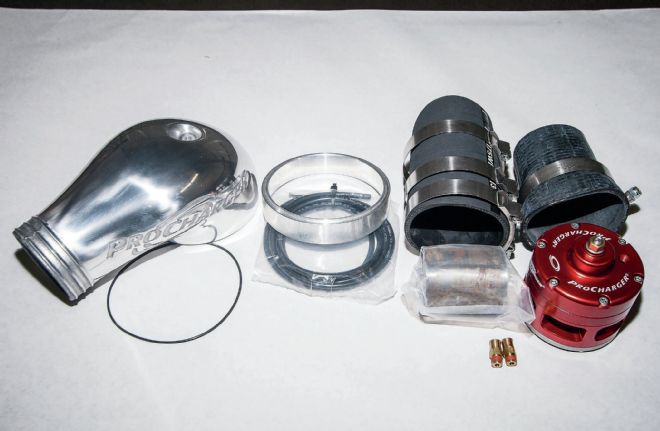
14. Here are some of the inlet components from the blow-through setup. Bob noted that the orientation of the high-flow carb hat should be 45-degrees to the front of the engine for the best performance. The infamous “Big Red” race valve is a must-have for big boost.
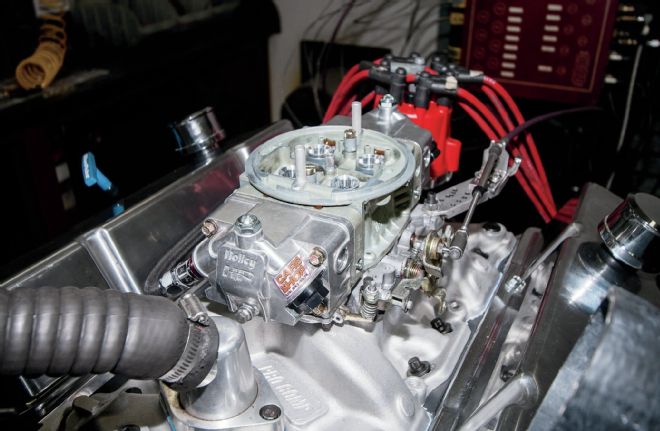
15. In preparation for boost, Bob swapped the first carb for another Holley 750-cfm double-pumper modified by the Carb Shop, but this one was designed for a blow-through setup.
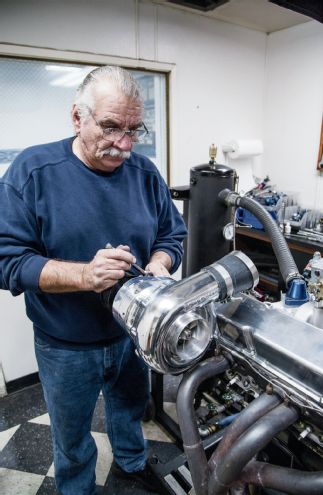
16. With the naturally aspirated pulls complete, it was time to see what this new snail was worth.
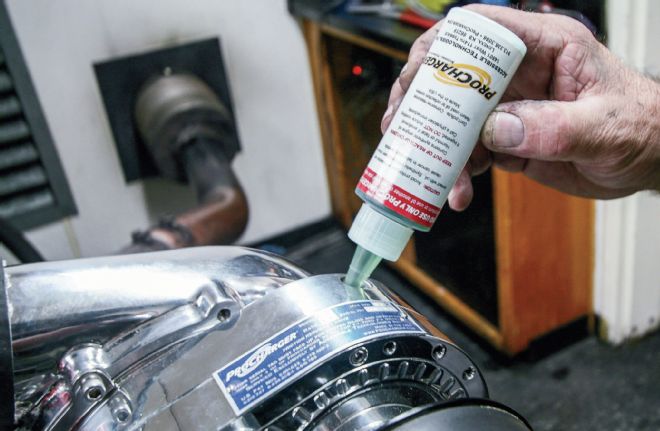
17. The F-1A-94 uses a self-contained oiling system but is shipped dry. Don’t forget to add the supplied oil.
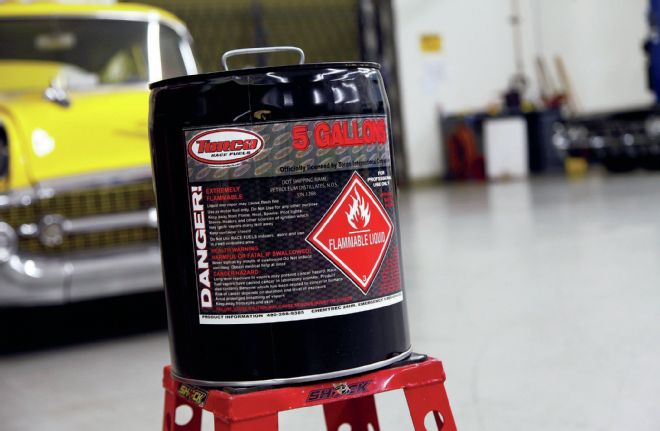
18. It’s hard to find race gas in California, so we were excited when we found Sunol Super Stop Race Fuels that has 95- and 100-octane at the pump, as well as many other higher-octane fuels like this Torco 118. We know its overkill since ProCharger blowers have extremely low IAT’s, but we were playing it safe.
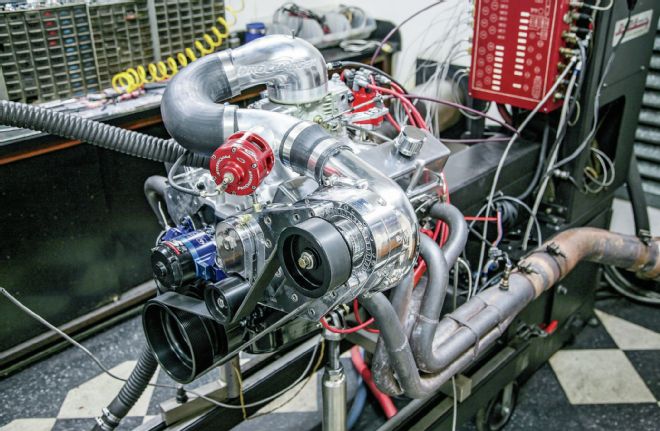
19. And there you have it. 383 cubic inches of BluePrint Engines crate engine ready for big boost from our ProCharger. On the highest boost setting, the engine liked 26 degrees of timing with the distributor locked and the rev ceiling kept at 5,500 rpm.